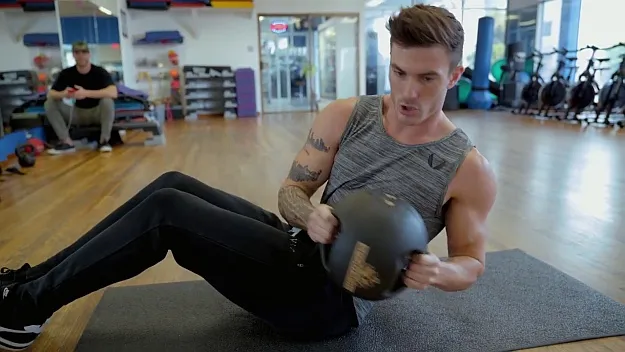Medicine Ball Abdominal Workouts: A Comprehensive Guide

in maintaining overall stability and strength. Among various training tools, the medicine ball stands out due to its versatility and effectiveness. This article explores the benefits of medicine ball abdominal workouts, provides a variety of exercises, and offers tips for incorporating these workouts into your fitness regimen.
Understanding the Medicine Ball
The medicine ball, traditionally used in rehabilitation, sports training, and strength conditioning, has evolved into a popular piece of gym equipment. Ranging from 2 to 30 pounds, medicine balls come in various sizes and weights, making them suitable for individuals of all fitness levels. Their unique design allows for dynamic movement, engaging multiple muscle groups simultaneously, which is particularly beneficial for core training.
Benefits of Medicine Ball Abdominal Workouts
- Enhanced Core Strength: Medicine ball workouts effectively target the rectus abdominis, obliques, and transverse abdominis. A stronger core translates to improved balance, stability, and posture.
- Increased Functional Fitness: Many daily activities require core strength. Medicine ball exercises mimic real-life movements, enhancing functional fitness and making everyday tasks easier.
- Improved Coordination and Balance: The dynamic nature of medicine ball exercises challenges coordination and balance, as the weight shifts during movement, requiring the body to stabilize.
- Versatile Training Options: Medicine balls can be used for various workouts, including strength training, cardio, and flexibility exercises, making them a versatile tool in any fitness routine.
- Engagement of Multiple Muscle Groups: Many medicine ball exercises engage not only the core but also the upper and lower body, promoting overall muscle development.
Key Muscle Groups Targeted
Before diving into specific exercises, it’s essential to understand the muscle groups involved in medicine ball abdominal workouts:
- Rectus Abdominis: This is the “six-pack” muscle that runs vertically along the front of the abdomen. It plays a significant role in flexing the spine and stabilizing the pelvis.
- Obliques: The external and internal obliques are located on the sides of the abdomen. They are responsible for rotational movements and lateral flexion of the spine.
- Transverse Abdominis: This deep core muscle wraps around the torso and acts as a stabilizer for the spine and pelvis.
- Erector Spinae: Located along the back, these muscles work alongside the core to maintain proper posture and support the spine.
Medicine Ball Abdominal Workouts
1. Medicine Ball Russian Twists
Target Muscles: Obliques, rectus abdominis
How to Perform:
- Sit on the floor with your knees bent and feet flat.
- Lean back slightly, keeping your back straight and core engaged.
- Hold a medicine ball with both hands and lift your feet off the ground (optional).
- Twist your torso to the right, bringing the medicine ball beside your hip.
- Return to the center and twist to the left.
- Repeat for 12-15 reps on each side.
2. Medicine Ball Slams
Target Muscles: Core, shoulders, legs
How to Perform:
- Stand with your feet shoulder-width apart, holding a medicine ball overhead.
- Engage your core and slam the ball down to the ground with force, bending your knees as you do.
- Catch the ball on the rebound and lift it back overhead.
- Repeat for 10-12 reps.
3. Medicine Ball Plank Pass
Target Muscles: Core, shoulders, chest
How to Perform:
- Begin in a plank position with the medicine ball on your right side.
- Reach with your right hand to grab the ball and pass it to your left side.
- Reach with your left hand to grab the ball and pass it back to the right side.
- Keep your body straight and core engaged throughout the movement.
- Repeat for 10-12 reps.
4. Medicine Ball Sit-Ups
Target Muscles: Rectus abdominis, hip flexors
How to Perform:
- Lie on your back with your knees bent and hold a medicine ball above your chest.
- Engage your core and perform a sit-up, bringing the medicine ball toward your knees.
- Slowly lower back down and repeat for 10-15 reps.
5. Medicine Ball Side Bends
Target Muscles: Obliques, transverse abdominis
How to Perform:
- Stand with your feet shoulder-width apart, holding a medicine ball with both hands at your side.
- Slowly bend to the right, bringing the ball down toward your knee.
- Return to the starting position and bend to the left.
- Repeat for 12-15 reps on each side.
6. Medicine Ball Leg Raises
Target Muscles: Lower abs, hip flexors
How to Perform:
- Lie on your back with your legs straight and a medicine ball held between your feet.
- Lift your legs and the ball toward the ceiling, keeping your lower back pressed against the floor.
- Slowly lower your legs back down, stopping just above the ground.
- Repeat for 10-12 reps.
7. Medicine Ball Toe Touches
Target Muscles: Rectus abdominis, obliques
How to Perform:
- Lie on your back with your legs raised straight up and a medicine ball in your hands.
- Engage your core and lift your upper body while reaching the medicine ball toward your toes.
- Slowly lower back down and repeat for 10-15 reps.
8. Medicine Ball Mountain Climbers
Target Muscles: Core, shoulders, legs
How to Perform:
- Start in a high plank position with your hands on the medicine ball.
- Engage your core and bring your right knee toward your chest.
- Quickly switch legs, bringing your left knee toward your chest.
- Continue alternating for 30 seconds.
Tips for Effective Medicine Ball Workouts
- Start with the Right Weight: Choose a medicine ball weight that allows you to maintain proper form throughout the exercise. If you’re new to strength training, starting with a lighter ball (4-8 lbs) is advisable.
- Warm-Up Properly: Always begin your workout with a proper warm-up to prepare your muscles and reduce the risk of injury. Dynamic stretches and light cardio can be effective.
- Focus on Form: Quality over quantity is crucial. Maintain proper form to avoid injury and maximize the effectiveness of each exercise.
- Incorporate Variety: To prevent boredom and promote overall core strength, include a variety of medicine ball exercises in your routine.
- Cool Down and Stretch: After your workout, take the time to cool down and stretch your core muscles to enhance flexibility and recovery.
- Listen to Your Body: If you experience pain (beyond typical muscle fatigue), stop the exercise and assess your form. It’s essential to differentiate between discomfort from a challenging workout and pain from improper form or injury.
Sample Medicine Ball Abdominal Workout Routine
Warm-Up (5-10 minutes):
- Jumping jacks
- Dynamic stretches (leg swings, torso twists)
Workout (3 rounds):
- Russian Twists: 15 reps each side
- Medicine Ball Slams: 12 reps
- Plank Pass: 10 reps
- Medicine Ball Sit-Ups: 15 reps
- Side Bends: 12 reps each side
- Mountain Climbers: 30 seconds
Cool Down (5-10 minutes):
- Static stretches focusing on the core, hips, and back.
Conclusion
Medicine ball abdominal workouts are an effective way to build core strength, improve functional fitness, and enhance overall athletic performance. With a wide range of exercises to choose from, you can customize your routine to meet your fitness goals and keep your workouts engaging. Remember to start with an appropriate weight, focus on form, and listen to your body as you progress. Whether you’re a beginner or a seasoned athlete, incorporating medicine ball exercises into your routine can lead to significant improvements in core strength and overall fitness.





